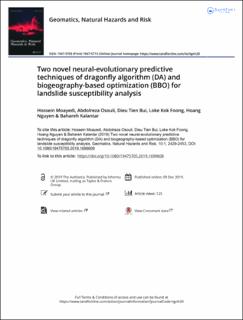Two novel neural-evolutionary predictivetechniques of dragonfly algorithm (DA) andbiogeography-based optimization (BBO)forlandslide susceptibility analysis
| dc.contributor.author | Moayedi, Hossein | |
| dc.contributor.author | Osouli, Abdolreza | |
| dc.contributor.author | Tien Bui, Dieu | |
| dc.contributor.author | Foong, Loke Kok | |
| dc.contributor.author | Nguyen, Hoang | |
| dc.contributor.author | Kalantar, Bahareh | |
| dc.date.accessioned | 2020-03-16T12:20:33Z | |
| dc.date.available | 2020-03-16T12:20:33Z | |
| dc.date.created | 2019-12-17T13:08:59Z | |
| dc.date.issued | 2019 | |
| dc.identifier.citation | Geomatics, Natural Hazards and Risk. 2019, 10 (1), 2429-2453. | en_US |
| dc.identifier.issn | 1947-5705 | |
| dc.identifier.uri | https://hdl.handle.net/11250/2646976 | |
| dc.description | Published by Informa UK Limited, trading as Taylor & Francis Group. This is an Open Access article distributed under the terms of the Creative Commons Attribution which permits unrestricted use, distribution, and reproduction in any medium, provided the original work is properly cited | en_US |
| dc.description.abstract | Due to the wide application of evolutionary science in different engineering problems, the main aim of this paper is to present two novel optimizations of multi-layer perceptron (MLP) neural network, namely dragonfly algorithm (DA) and biogeography-based optimization (BBO) for landslide susceptibility assessment at a study area, West of Iran. Utilizing 14 landslide conditioning factors, namely elevation, slope aspect, plan curvature, profile curvature, soil type, lithology, distance to the river, distance to the road, distance to the fault, land cover, slope degree, stream power index (SPI), and topographic wetness index (TWI) and rainfall as the input variables, and 208 historical landslides as target variable, the required spatial database is created. Then, the MLP is synthesized with the mentioned algorithms to develop the proposed DA-MLP and BBO-MLP ensembles. Three accuracy criteria of mean square error, mean absolute error, and area under the receiving operating characteristic curve are used to evaluate the performance of the models and also to develop a score-based ranking system. As the first outcome, the application of the DA and BBO metaheuristic algorithms enhances the accuracy of the MLP. Moreover, referring to the calculated total ranking scores of 6, 14, and 16, it was revealed that the BBO performs more efficiently than DA in optimizing the MLP. | en_US |
| dc.language.iso | eng | en_US |
| dc.rights | Navngivelse 4.0 Internasjonal | * |
| dc.rights.uri | http://creativecommons.org/licenses/by/4.0/deed.no | * |
| dc.title | Two novel neural-evolutionary predictivetechniques of dragonfly algorithm (DA) andbiogeography-based optimization (BBO)forlandslide susceptibility analysis | en_US |
| dc.type | Peer reviewed | en_US |
| dc.type | Journal article | en_US |
| dc.description.version | publishedVersion | en_US |
| dc.rights.holder | (c) 2019 The Author(s). | en_US |
| dc.source.pagenumber | 2429-2453 | en_US |
| dc.source.volume | 10 | en_US |
| dc.source.journal | Geomatics, Natural Hazards and Risk | en_US |
| dc.source.issue | 1 | en_US |
| dc.identifier.doi | 10.1080/19475705.2019.1699608 | |
| dc.identifier.cristin | 1761912 | |
| cristin.ispublished | true | |
| cristin.fulltext | original | |
| cristin.qualitycode | 1 |
Tilhørende fil(er)
Denne innførselen finnes i følgende samling(er)
-
Institutt for økonomi og it [152]
-
Publikasjoner fra CRIStin [3417]

